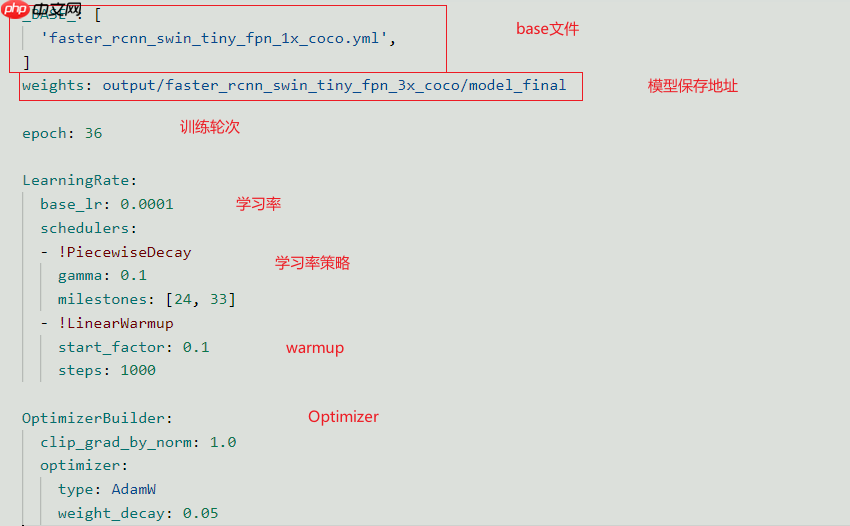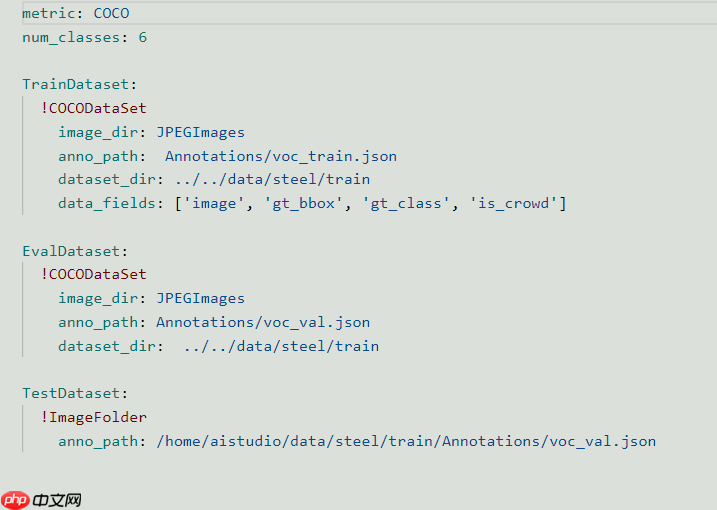本文介绍了基于PaddleDetection套件进行钢铁表面缺陷识别的实践过程。先介绍赛题及NEU数据集,含6种热轧带钢缺陷。接着说明数据准备步骤,包括解压、安装工具、改名、拆分及格式转换。然后详述用faster_rcnn_swin_tiny_fpn_3x_coco模型的训练流程,涉及配置文件修改、训练评估,最后提及推理及生成比赛数据的方法。
☞☞☞AI 智能聊天, 问答助手, AI 智能搜索, 免费无限量使用 DeepSeek R1 模型☜☜☜

作为一个新人练习赛,这个比赛可以非常好的帮助大家熟悉使用Paddle。在这里我使用PaddleDetection套件中的网络进行训练,本项目将带大家对PaddleDetection套件使用有一个实践的过程。
本数据集来自NEU表面缺陷检测数据集,收集了6种典型的热轧带钢表面缺陷,即氧化铁皮压入(RS)、斑块(Pa)、开裂(Cr)、点蚀(PS)、夹杂(In)和划痕(Sc)。
可在比赛页面看到详情:https://aistudio.baidu.com/aistudio/competition/detail/114/0/task-definition
# 解压文件并移除多余的目录! unzip /home/aistudio/data/data105746/train.zip -d /home/aistudio/data/steel !rm -r /home/aistudio/data/steel/__MACOSX ! unzip /home/aistudio/data/data105747/test.zip -d /home/aistudio/data/steel !rm -r /home/aistudio/data/steel/__MACOSX
# 安装paddlex 用于拆分数据集# 升级pip!pip install --upgrade pip -i https://mirror.baidu.com/pypi/simple !pip install "paddlex>2.0.0" -i https://mirror.baidu.com/pypi/simple
# 修改文件名字 JPEGImages Annotations!mv /home/aistudio/data/steel/train/ANNOTATIONS /home/aistudio/data/steel/train/Annotations !mv /home/aistudio/data/steel/train/IMAGES /home/aistudio/data/steel/train/JPEGImages
#使用paddleX拆分数据集!paddlex --split_dataset --format VOC --dataset_dir /home/aistudio/data/steel/train --val_value 0.001 --test_value 0.0
# 下载PaddleDetection%cd /home/aistudio/work !git clone https://gitee.com/paddlepaddle/PaddleDetection.git -b release/2.3
# 进入PaddleDetection%cd /home/aistudio/work/PaddleDetection# 安装其它依赖!pip install -r /home/aistudio/work/PaddleDetection/requirements.txt # 临时环境安装!pip install pycocotools -i https://mirror.baidu.com/pypi/simple !pip install lap -i https://mirror.baidu.com/pypi/simple
%cd /home/aistudio/work/PaddleDetection/#转换train!python tools/x2coco.py \
--dataset_type voc \
--voc_anno_dir /home/aistudio/data/steel/train/ \
--voc_anno_list /home/aistudio/data/steel/train/train_list.txt \
--voc_label_list /home/aistudio/data/steel/train/labels.txt \
--voc_out_name /home/aistudio/data/steel/train/voc_train.json#转换test!python tools/x2coco.py \
--dataset_type voc \
--voc_anno_dir /home/aistudio/data/steel/train/ \
--voc_anno_list /home/aistudio/data/steel/train/val_list.txt \
--voc_label_list /home/aistudio/data/steel/train/labels.txt \
--voc_out_name /home/aistudio/data/steel/train/voc_val.json
!rm -r /home/aistudio/data/steel/train/Annotations/*
!mv /home/aistudio/data/steel/train/*.json /home/aistudio/data/steel/train/Annotations/可以将一些需要改动的参数放到此文件中,这样就不会防止改动了里面得文件导致使用其他模型时还要再去那个文件进行改动。此文件的参数优先级高于其他base文件。


我们最需要改的是 第一个得数据集配置文件,以及训练参数配置文件。
改成如下。具体路径可以自己琢磨一下 
# 训练!python tools/train.py -c configs/faster_rcnn/faster_rcnn_swin_tiny_fpn_3x_coco.yml --use_vdl=true --vdl_log_dir=vdl_dir/scalar --eval
# 单卡断点续训# !python tools/train.py -c configs/faster_rcnn/faster_rcnn_swin_tiny_fpn_3x_coco.yml \# -r /home/aistudio/work/output/faster_rcnn_swin_tiny_fpn_3x_coco/best \# --eval \# --use_vdl=true \# --vdl_log_dir=vdl_dir/scalar \# --eval
# 推理图像和生成txt文件!python tools/infer.py -c configs/faster_rcnn/faster_rcnn_swin_tiny_fpn_3x_coco.yml \ -o weights=/home/aistudio/work/PaddleDetection/output/faster_rcnn_swin_tiny_fpn_3x_coco/34 \ --infer_dir=/home/aistudio/data/steel/test/IMAGES/ \ --output_dir=/home/aistudio/data/steel/infer_output\ --draw_threshold=0.005 --save_txt=True
import csvimport os
headers = ['image_id','bbox','category_id','confidence']
classList = ['crazing','inclusion','pitted_surface','scratches','patches','rolled-in_scale']
rows = []
rootdir = '/home/aistudio/data/steel/infer_output'list = os.listdir(rootdir) #列出文件夹下所有的目录与文件for i in range(0,len(list)):
path = os.path.join(rootdir,list[i]) if os.path.isfile(path) and path.endswith('txt'):
txtFile = open(path) print(path)
result = txtFile.readlines() for r in result:
ls = r.split(' ')
Cls = ls[0]
sco = float(ls[1])
xmin = float(ls[2])
ymin = float(ls[3])
w = float(ls[4])
h = float(ls[5])
xmax = xmin+w
ymax = ymin+h
clsID = classList.index(Cls)
imgID = list[i][:-4]
row = [imgID,[xmin,ymin,xmax,ymax],clsID,sco]
rows.append(row)with open('submission.csv','w')as f:
f_csv = csv.writer(f)
f_csv.writerow(headers)
f_csv.writerows(rows)import pandas as pd
datafile = pd.read_csv('/home/aistudio/work/PaddleDetection/submission.csv')# 按照列值排序data = datafile.sort_values(by="image_id", ascending=True)
data.to_csv('submission_final.csv', mode='a+', index=False)以上就是飞桨新人赛:钢铁缺陷检测挑战赛-第1名方案的详细内容,更多请关注php中文网其它相关文章!

每个人都需要一台速度更快、更稳定的 PC。随着时间的推移,垃圾文件、旧注册表数据和不必要的后台进程会占用资源并降低性能。幸运的是,许多工具可以让 Windows 保持平稳运行。

Copyright 2014-2025 https://www.php.cn/ All Rights Reserved | php.cn | 湘ICP备2023035733号